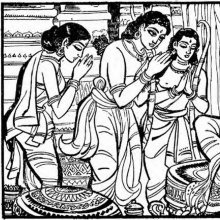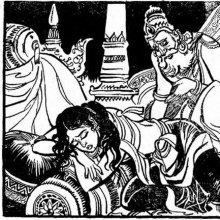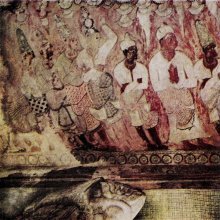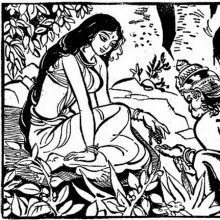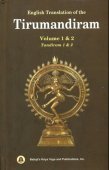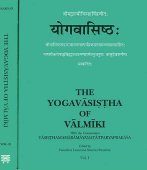Tat, Tāt, Taṭ: 15 definitions
Introduction:
Tat means something in Hinduism, Sanskrit, Hindi, Tamil. If you want to know the exact meaning, history, etymology or English translation of this term then check out the descriptions on this page. Add your comment or reference to a book if you want to contribute to this summary article.
Images (photo gallery)
(+1257 more images available)
In Hinduism
Vyakarana (Sanskrit grammar)
Source: Wikisource: A dictionary of Sanskrit grammar1) Tāt (तात्).—The same as तातङ् (tātaṅ) substituted for तु (tu) and हि (hi) of the imperative sec. and third sing. Parasmaipada; cf. P.VII.1.35;
2) Tāt.—Substitute तात् (tāt) for त (ta) of the imperative 2nd pl. in Vedic Literature; e.g. गात्रं गात्रमस्यानूनं कृणुतात् (gātraṃ gātramasyānūnaṃ kṛṇutāt) cf. Kas on P.VII.1.44.

Vyakarana (व्याकरण, vyākaraṇa) refers to Sanskrit grammar and represents one of the six additional sciences (vedanga) to be studied along with the Vedas. Vyakarana concerns itself with the rules of Sanskrit grammar and linguistic analysis in order to establish the correct context of words and sentences.
Vaishnavism (Vaishava dharma)
Source: Pure Bhakti: Bhagavad-gita (4th edition)Tat (तत्) refers to “supreme Spirit (brahma); the cause of the universe”. (cf. Glossary page from Śrīmad-Bhagavad-Gītā).

Vaishnava (वैष्णव, vaiṣṇava) or vaishnavism (vaiṣṇavism) represents a tradition of Hinduism worshipping Vishnu as the supreme Lord. Similar to the Shaktism and Shaivism traditions, Vaishnavism also developed as an individual movement, famous for its exposition of the dashavatara (‘ten avatars of Vishnu’).
General definition (in Hinduism)
Source: WikiPedia: HinduismThe word tat = that is part of the compound 'tatsavitur'. As a result, in its split form, 'tat' is taken in its genitive form 'tasya' since the genitive case of the whole compound applies to each of its constituent words.
Languages of India and abroad
Sanskrit dictionary
Source: DDSA: The practical Sanskrit-English dictionaryTaṭ (तट्).—I. 1 P. (taṭati)
1) To groan.
2) To rise, be raised or elevated. -II. 1 U. (tāṭayati-te) To beat, strike.
Source: Cologne Digital Sanskrit Dictionaries: Shabda-Sagara Sanskrit-English DictionaryTaṭ (तट्).—[taṭa] r. 1st cl. (taṭati) To be elevated or high, to rise. r. 10th cl. (tāṭayatite) To beat.
--- OR ---
Tat (तत्).—ind. Therefore, thence, the consequent or correlative to yat. E. tan to spread, or extend, affix kvip.
Source: Cologne Digital Sanskrit Dictionaries: Benfey Sanskrit-English DictionaryTaṭ (तट्).—i. 1 or 6, [Parasmaipada.] To groan (ved.). † i. 1. To rise; i. 10, tāṭaya, [Parasmaipada.] v. r. of 1. taḍ.
Source: Cologne Digital Sanskrit Dictionaries: Cappeller Sanskrit-English DictionaryTaṭ (तट्).—taṭati rumble, groan.
--- OR ---
Tāt (तात्).—([ablative] [adverb]) thus, then.
Source: Cologne Digital Sanskrit Dictionaries: Monier-Williams Sanskrit-English Dictionary1) Ṭāt (टात्):—ind. (onomatopoetic) with √kṛ, to cause to jingle or rattle, [Prasannarāghava i, 32.]
2) Taṭ (तट्):—[class] 1. [Parasmaipada] ṭati, to rumble, [ṢaḍvBr. v, 7];
2) — (derived [from] taṭa) to be raised, [Dhātupāṭha ix, 21] :—[Causal] tāṭayati [varia lectio] for tāḍay, to strike, [xxxii, 43].
3) Tat (तत्):—1a for tad. See [column]3.
4) 2a 2 tata. See √tan
5) 1b in [compound] for tad.
6) [from tan] 2b mfn. ifc. See parī-
7) [v.s. ...] cf. purī-tat.
8) Tāt (तात्):—ind. ([obsolete] [ablative] of 2. ta) thus, in this way, [Ṛg-veda vi, 21, 6; x, 95, 16;] [obsolete] [accusative] [plural] ([!]) of 2. ta, [Pāṇini; vii, 1, 39; Kāśikā-vṛtti]; cf. adhas-tāt etc.
Source: Cologne Digital Sanskrit Dictionaries: Yates Sanskrit-English Dictionary1) Taṭ (तट्):—taṭati 1. a. To be elevated or high; to rise. (ka) tāṭayati 10. a. To beat, to persecute.
2) Tat (तत्):—conj. Therefore, thence.
Source: DDSA: Paia-sadda-mahannavo; a comprehensive Prakrit Hindi dictionary (S)Tat (तत्) in the Sanskrit language is related to the Prakrit words: Ṇa, Ta, Taṃ.
[Sanskrit to German]
Sanskrit, also spelled संस्कृतम् (saṃskṛtam), is an ancient language of India commonly seen as the grandmother of the Indo-European language family (even English!). Closely allied with Prakrit and Pali, Sanskrit is more exhaustive in both grammar and terms and has the most extensive collection of literature in the world, greatly surpassing its sister-languages Greek and Latin.
Hindi dictionary
Source: DDSA: A practical Hindi-English dictionary1) Tat in Hindi refers in English to:—(nm) a bank; coast, shore..—tat (तट) is alternatively transliterated as Taṭa.
2) Tat (तत्):—(pro) that; ~[paścāt] thereafter; ~[puruṣa] (in Grammar) a variety of [samāsa].
...
Tamil dictionary
Source: DDSA: University of Madras: Tamil LexiconTat (தத்) interjection [K. tat.] Exclamation meaning tut; அதட்டற்குறிப்பு. [athattarkurippu.] Local usage
--- OR ---
Tat (தத்) < tat. adjectival That; அந்த. தத்திருப்பதி [antha. thathiruppathi] (திருப்புகழ் [thiruppugazh] 124). — pronominal That; அது. தத்தொமசி [athu. thathomasi] (வேதாந்த சூளாமணிமணிமேகலை [vethanda sulamani] 117).
Tamil is an ancient language of India from the Dravidian family spoken by roughly 250 million people mainly in southern India and Sri Lanka.
Nepali dictionary
Source: unoes: Nepali-English DictionaryTat (तत्):—pron. (first person singular) that;
Nepali is the primary language of the Nepalese people counting almost 20 million native speakers. The country of Nepal is situated in the Himalaya mountain range to the north of India.
See also (Relevant definitions)
Starts with (+1377): Taccheda, Tajjnataka, Tallakshana, Tat-ekatiyanam, Tat-kitticanni, Tat-kung, Tat-kungasing, Tat-pada-parigrihita, Tat-pong, Tat-tuvamaci, Tata, Tata bateri, Tata pusia, Tata-amba, Tata-Kana-Kara-Dini-Dishi, Tata-paltanu, Tata-putaenal, Tata-tatayati, Tata-tatayayi, Tata-youba.
Ends with (+74): Abhinishpatat, Abhipatat, Adhahpatat, Adharastat, Adharattat, Adhastat, Adhatat, Ahatat, Akutat, Anetat, Antaratat, Antat, Apaktat, Apurastat, Arattat, Arttat, Asamantat, Avarastat, Avastat, Ayatat.
Full-text (+74213): Tatkala, Tanmatra, Dhat, Tad, Tatkara, Tadanantara, Nikata, Tavattat, Dvidat, Tatratya, Tatkshana, Shuddhadat, Arokadat, Tatparayana, Tatpurva, Avacakshe, Ayodat, Tadanta, Ubhayatodat, Tatpurvam.
Relevant text
Search found 576 books and stories containing Tat, Dat, Dhat, Tāt, Taṭ, Ṭāt, That; (plurals include: Tats, Dats, Dhats, Tāts, Taṭs, Ṭāts, Thats). You can also click to the full overview containing English textual excerpts. Below are direct links for the most relevant articles:
Rig Veda (translation and commentary) (by H. H. Wilson)
A Single Mind (by Ajaan Fuang Jotiko)
Bodhinyana (by Ajahn Chah)
Part 2 - The Worldly Way And Liberation < [Chapter 4 - The Two Faces Of Reality]
Part 5 - The Forest Of The Senses < [Chapter 4 - The Two Faces Of Reality]
Feeling Conditions Desire (by Ajahn Sumedho)
Ignorance is the Self-View (by Ajahn Sumedho)
Things as They Are (by Acariya Maha Boowa Nanasampanno)
Related products
(+405 more products available)


